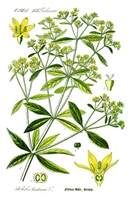Green batteries: extract of madder plant works as lithium-ion cathode
13 Dec 2012
Rose madder – a natural plant dye once prized throughout the Old World to make fiery red textiles – has found a second life as the basis for a new ''green'' battery.
 Scientists at Rice University and the City College of New York have discovered that the madder plant (known as manjeeth and manjistha in Hindi), aka Rubia tinctorum, is a good source of purpurin, an organic dye that can be turned into a highly effective, natural cathode for lithium-ion batteries. The plant has been used since ancient times to create dye for fabrics.
Scientists at Rice University and the City College of New York have discovered that the madder plant (known as manjeeth and manjistha in Hindi), aka Rubia tinctorum, is a good source of purpurin, an organic dye that can be turned into a highly effective, natural cathode for lithium-ion batteries. The plant has been used since ancient times to create dye for fabrics.
Chemists from The City College of New York teamed with researchers from Rice University and the US Army Research Laboratory to develop a non-toxic and sustainable lithium-ion battery powered by purpurin, a dye extracted from the roots of the madder plant (Rubia species).
More than 3,500 years ago, civilizations in Asia and the Middle East first boiled madder roots to colour fabrics in vivid oranges, reds and pinks.
In its latest technological incarnation, the climbing herb could lay the foundation for an eco-friendly alternative to traditional lithium-ion (Li-ion) batteries. These batteries charge everything from your mobile phone to electric vehicles, but carry with them risks to the environment during production, recycling and disposal.
''Purpurin,'' on the other hand, said team member and City College Professor of Chemistry George John, ''comes from nature and it will go back to nature.'' The team reported their results in the journal Nature's online and open access publication, Scientific Reports, on 11 December 2012.
 Most Li-ion batteries today rely on finite supplies of mined metal ores, such as cobalt. ''Thirty percent of globally produced cobalt is fed into battery technology,'' noted Dr. Leela Reddy, lead author and a research scientist in Professor Pulickel Ajayan's lab in the Department of Mechanical Engineering and Materials Science at Rice University. The cobalt salt and lithium are combined at high temperatures to make a battery's cathode, the electrode through which the electric current flows.
Most Li-ion batteries today rely on finite supplies of mined metal ores, such as cobalt. ''Thirty percent of globally produced cobalt is fed into battery technology,'' noted Dr. Leela Reddy, lead author and a research scientist in Professor Pulickel Ajayan's lab in the Department of Mechanical Engineering and Materials Science at Rice University. The cobalt salt and lithium are combined at high temperatures to make a battery's cathode, the electrode through which the electric current flows.
Mining cobalt metal and transforming it, however, is expensive, Dr. Reddy explained. Fabricating and recycling standard Li-ion batteries demands high temperatures, guzzling costly energy, especially during recycling. ''In 2010, almost 10 billion lithium-ion batteries had to be recycled,'' he said .
Production and recycling also pumps an estimated 72 kilograms of carbon dioxide – a greenhouse gas – into the atmosphere for every kilowatt-hour of energy in a Li-ion battery, he noted. These grim facts have fed a surging demand to develop green batteries, said Dr. Reddy.
Fortunately, biologically based color molecules, like purpurin and its relatives, seem pre-adapted to act as a battery's electrode. In the case of purpurin, the molecule's six-membered (aromatic) rings are festooned with carbonyl and hydroxyl groups adept at passing electrons back and forth, just as traditional electrodes do. ''These aromatic systems are electron-rich molecules that easily coordinate with lithium,'' explained Professor John.
Moreover, growing madder or other biomass crops to make batteries would soak up carbon dioxide and eliminate the disposal problem – without its toxic components, a lithium-ion battery could be thrown away.
Best of all, purpurin also turns out to be a no-fuss ingredient. ''In the literature there are one or two other natural organic molecules in development for batteries, but the process to make them is much more tedious and complicated,'' noted Professor John.
Made and stored at room temperature, the purpurin electrode is made in just a few easy steps: dissolve the purpurin in an alcohol solvent and add lithium salt. When the salt's lithium ion binds with purpurin the solution turns from reddish yellow to pink. Remove the solvent and it's ready. ''The chemistry is quite simple,'' coauthor and City College postdoctoral researcher Dr. Subbiah Nagarajan explained.
The team estimates that a commercial green Li-ion battery may be only a few years away, counting the time needed to ramp up purpurin's efficiency or hunt down and synthesize similar molecules. ''We can say it is definitely going to happen, and sometime soon, because in this case we are fully aware of the mechanism,'' said Professor John.
''Green batteries are the need of the hour, yet this topic hasn't really been addressed properly,'' Reddy says. ''This is an area that needs immediate attention and sustained thrust, but you cannot discover sustainable technology overnight. The current focus of the research community is still on conventional batteries, meeting challenges like improving capacity. While those issues are important, so are issues like sustainability and recyclability.''
While lithium-ion batteries have become standard in conventional electronics since their commercial introduction in 1991, the rechargeable units remain costly to manufacture, Reddy said. ''They're not environmentally friendly. They use cathodes of lithium cobalt oxide, which are very expensive. You have to mine the cobalt metal and manufacture the cathodes in a high-temperature environment. There are a lot of costs.
''And then, recycling is a big issue,'' he says. ''In 2010, almost 10 billion lithium-ion batteries had to be recycled, which uses a lot of energy. Extracting cobalt from the batteries is an expensive process.''
Reddy and his colleagues came across purpurin while testing a number of organic molecules for their ability to electrochemically interact with lithium and found purpurin most amenable to binding lithium ions. With the addition of 20 per cent carbon to add conductivity, the team built a half-battery cell with a capacity of 90 milliamp hours per gram after 50 charge / discharge cycles. The cathodes can be made at room temperature, he said.
''It's a new mechanism we are proposing with this paper, and the chemistry is really simple,'' Reddy said. He suggested agricultural waste may be a source of purpurin, as may other suitable molecules, which makes the process even more economical.
Innovation in the battery space is needed to satisfy future demands and counter environmental issues like waste management, ''and hence we are quite fascinated by the ability to develop alternative electrode technologies to replace conventional inorganic materials in lithium-ion batteries,'' says Ajayan, Rice's Benjamin M. and Mary Greenwood Anderson Professor in Mechanical Engineering and Materials Science and of chemistry.
''We're interested in developing value-added chemicals, products and materials from renewable feedstocks as a sustainable technology platform,'' says co-lead author George John, a professor of chemistry at the City College of New York-CUNY and an expert on bio-based materials and green chemistry.
''The point has been to understand the chemistry between lithium ions and the organic molecules. Now that we have that proper understanding, we can tap other molecules and improve capacity,'' adds John.
''When you can generate something new or unheard of, you think of chemistry in a different way,'' he adds. ''That a natural material or dye can be used for a battery, that is exciting, even for me.''
Recent work by the Ajayan's group combines silicon and a porous nickel current collector in a way that has proven effective as a high-capacity anode, the other electrode in a lithium-ion battery.
That research was reported recently in the American Chemical Society journal Nano Letters.
But Reddy hopes to formulate completely green batteries. The team is looking for organic molecules suitable for anodes and for an electrolyte that doesn't break the molecules down.
He expects to have a working prototype of a complete organic battery within a few years. ''What we've come up with should lead to much more discussion in the scientific community about green batteries,'' he says.






























